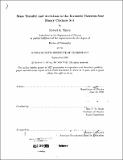| dc.contributor.advisor | Hale V.D. Bradt. | en_US |
| dc.contributor.author | Shirley, Robert Edward, 1972- | en_US |
| dc.date.accessioned | 2009-10-01T15:33:14Z | |
| dc.date.available | 2009-10-01T15:33:14Z | |
| dc.date.copyright | 1998 | en_US |
| dc.date.issued | 1998 | en_US |
| dc.identifier.uri | http://hdl.handle.net/1721.1/47699 | |
| dc.description | Thesis (Ph.D.)--Massachusetts Institute of Technology, Dept. of Physics, 1998. | en_US |
| dc.description | Includes bibliographical references (p. 199-206). | en_US |
| dc.description.abstract | I have carried out a project to study the eccentric neutron-star binary Circinus X-1 through an extensive series of observational studies with the Rossi X-ray Timing Explorer satellite and through theoretical computer models I developed to explore mass transfer and evolution in an eccentric binary. We also organized two multi-frequency campaigns to study correlated variability in different frequency bands. The X-ray observations showed that the intensity of Cir X- 1 currently maintains a bright baseline level, with strong flares occurring after phase zero of each 16.55-day cycle of the source. This behavior is thought to be due to enhanced mass transfer occurring near periastron of a highly eccentric binary orbit. Dips below the baseline intensity level also occur near phase zero. I modeled the evolution of the energy spectrum during dips with a variably absorbed bright component plus a fainter unabsorbed component. I show that variability not attributable to absorption dips is related to the spectral/intensity states of the "Z source" class of low-mass X-ray binaries (LMXBs), namely motion along (or shifts of) the horizontal, normal, and flaring branches of the "Z" track in color-color and hardness-intensity diagrams. I found rapid X-ray variability properties associated with each spectral/intensity state: On the horizontal branch, quasi-periodic oscillations (QPOs) in the X-ray intensity shift in frequency from 1.3 to 35 Hz. On the normal branch, a different QPO occurs at about 4 Hz. On the flaring branch only strong aperiodic variability occurs. I modeled the evolution of the energy spectra associated with each of these branches. To study mass transfer in an eccentric binary, I developed computer codes for transfer via Rochelobe overflow and from a stellar wind. I derive theoretical mass accretion profiles and compare them to the observed profile of the X-ray intensity. In order to explore the possible evolutionary history of Circinus X-1, I developed a binaryevolution computer code for a neutron-star and low-mass companion in an eccentric orbit. I use this code in a population-synthesis study to show that the number of systems in the Galaxy expected to resemble Cir X-1 is of order unity, consistent with its unique status as an LMXB with high eccentricity. | en_US |
| dc.description.statementofresponsibility | by Robert E. Shirley. | en_US |
| dc.format.extent | 206 p. | en_US |
| dc.language.iso | eng | en_US |
| dc.publisher | Massachusetts Institute of Technology | en_US |
| dc.rights | M.I.T. theses are protected by
copyright. They may be viewed from this source for any purpose, but
reproduction or distribution in any format is prohibited without written
permission. See provided URL for inquiries about permission. | en_US |
| dc.rights.uri | http://dspace.mit.edu/handle/1721.1/7582 | en_US |
| dc.subject | Physics | en_US |
| dc.title | Mass transfer and accretion in the eccentric neutron-star binary Circinus X-1 | en_US |
| dc.type | Thesis | en_US |
| dc.description.degree | Ph.D. | en_US |
| dc.contributor.department | Massachusetts Institute of Technology. Department of Physics | en_US |
| dc.identifier.oclc | 42283884 | en_US |

